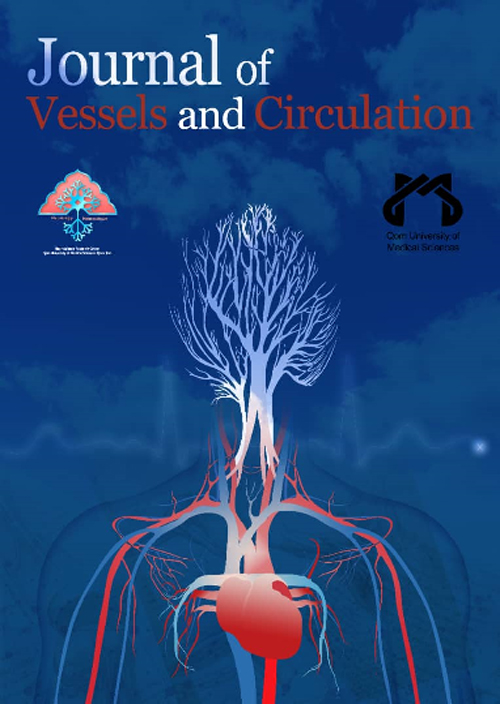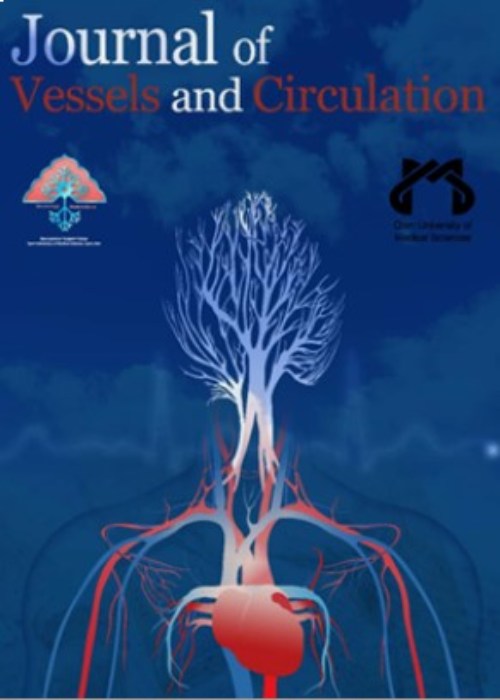فهرست مطالب

Journal of Vessels and Circulation
Volume:2 Issue: 1, Winter 2021
- تاریخ انتشار: 1399/11/10
- تعداد عناوین: 7
-
-
Pages 1-8Background and Aim
Cellulite is the most common soft tissue infection in children. Children are more prone to cellulite because they are more susceptible to trauma, insect or animal bites, and wounds and scratches. The aim of this study was to determine the frequency of causes, complications and treatment of cellulite in Hazrat Masoumeh Hospital in Qom.
Materials & MethodsThis descriptive study was performed on all patients admitted to Hazrat Masoumeh Hospital in Qom during 2013-2014. Data were extracted from patientschr(chr('39')39chr('39')) medical records and subjected to statistical analysis.
ResultsThe mean age was 38.15 ± 42.94 The prevalence of sex was almost the same. The most affected areas were lower extremities 43%, upper extremities 26.5%, face and eyes 6.6%. The most common clinical manifestations were edema 75%, redness 62% and fever 38%. The most commonly prescribed antibiotics were ceftriaxone 47%, cloxacillin 34.7% and clindamycin 28%. The most common underlying causes included bite 16%, trauma 10% and previous wound 9%. Complications reported included abscesses of 10% and osteomyelitis of 1.6%. The mean ESR was 32.46 26 26, CRP23 ± 24.14, WBC 4587 ± 12261. Preference was seen with PMN at 80.5%. Blood culture was positive in 8% and according to the response of antibiograms, the highest resistance was to cefazolin and then ceftriaxone and the highest sensitivities were to imipenem and ceftazidime.
ConclusionFinally, due to the limitations of retrospective research in collecting information correctly and planned, it seems that instead of future research, which has a more focused approach to evaluating specific treatments and diagnostic methods for diseases such as cellulite, is still empty in Iran and needs to be done. This research is felt. Research that can determine the prevalence of organisms involved in this disease in the area where we live, as well as the appropriate type of treatment for all inpatients and outpatients.
Keywords: Causes, Cellulite, Hospital -
Pages 9-16Background and Objectives
Exercise plays a protective and preventive role against heart disease by reducing risk factors. The aim of the present study was to investigate the effect of a period of resistance training by muscle endurance method on blood pressure, heart rate and plasma endothelin 1 levels of inactive healthy men.
MethodsIn this quasi-experimental study, 30 middle-aged men (mean age 47.03± 2.12 years, height 172.90 ± 3 cm, weight 80.70 ± 3.1 kg, body mass index 47.47 ± 3.66 27 kg / m2 and waist to pelvis ratio (0.98 ± 1.27) were purposefully selected and randomly divided into two groups of 15 control and experimental. The experimental group performed 8 weeks of resistance training, three sessions per week with an intensity of 40 to 70% of a maximum repetition. Before and after 8 weeks of exercise, plasma endothelin-1, systolic and diastolic blood pressure and resting heart rate were measured. Correlated t-test was used to examine intragroup changes and independent t-test was used for intergroup differences. Significance level was considered less than 0.05.
ResultsThe results of this study showed that 8 weeks of muscular endurance resistance training significantly reduced the plasma endothelin level of inactive middle-aged men (P = 0.002). Also, 8 weeks of resistance training caused a significant decrease in systolic blood pressure (P = 0.001) and resting heart rate (P = 0.01) in middle-aged men, but the decrease in diastolic blood pressure was not significant (P = 0.0411).
ConclusionAccording to the results of the present study, muscular endurance resistance training by reducing plasma endothelin-1 levels, systolic blood pressure and resting heart rate can reduce the risk of hypertension and heart disease in healthy middle-aged men as a preventive factor.
Keywords: Resistance training, Endothelin 1, Blood pressure, Heart Rate -
Pages 17-25Background and Objectives
Aging is a process in which most of the bodychr(chr(chr('39')39chr('39'))39chr(chr('39')39chr('39')))s physiological structures and functions gradually weaken and decline. The aim of this study was to investigate the effect of 8 weeks of selected Pilates exercises on balance, body composition and blood pressure in healthy elderly women.
MethodsThis quasi-experimental randomized study with pre-test and post-test design on 20 inactive elderly women with mean (age 62 ± 2.5 years, height 160.6 4 4.51 cm and weight 67.70 4 4.60 kg ) Done. Participants were randomly divided into experimental (n = 10) and control (n = 10) groups. The experimental group participated in the Pilates program for 8 weeks and 3 sessions per week. During this period, the control group did not participate in any training program. The pre-test of the training group was performed before the beginning of the exercises and the post-test was performed after 8 weeks of training and the results of both groups were compared. Kolmogorov-Smirnov test was used to analyze the data and paired t-test and analysis of variance were used to analyze the within-group findings and analysis of variance, respectively. Significance level was considered less than 0.05.
ResultsFindings of the present study showed that 8 weeks of Pilates training had a significant effect on static balance and dynamic balance of body fat in the post-test compared to the pre-test of the experimental group (P = 0.001). Also, the results showed that Pilates exercises on static balance (04 P = 0.), dynamic (P = 0.00) and fat percentage (P = 0.001) had a significant effect on the post-test of the experimental group compared to the control group.
ConclusionPilates largely avoids high impact, high power output, and heavy muscular and skeletal loading. Pilates largely avoids high impact, high power output, and heavy muscular and skeletal loading. However, more studies are needed on the effect of this type of exercise on body composition and blood pressure in older women.
Keywords: Pilates, Balance, blood pressure, body composition, the elderly -
Pages 27-32Introduction
Following the development of technology and the increase of intensive care beds has led to the highest level of need for professional care team in these departments. In addition, intensive care personnel are exposed to serious occupational stressors such as time pressure reduced social support, overwork, and spiritual and moral distress. The aim of this study was to explain the strategies for promoting quality care in pediatric angiography
MethodThis is a qualitative study that was conducted purposefully with the participation of 20 members of the care team. Sampling was done until data saturation. Data analysis was performed using qualitative content analysis.
FindingsBy analyzing the data, three categories were identified that included categories of structural correction, human management modification and human interaction modification .
ConclusionFindings of this study show that strategies to improve the management of the angiography department are affected by various factors such as structural management correction, human management, and human interaction correction. Therefore, in order to improve the management of this department, it is necessary to align managers in the field of standardization of the department and increase the level of communication skills of the care team
Keywords: Angiography, quality of care, management -
Pages 33-42Background
Coronary artery diseases (CAD) affect much different physical, social and economic aspects of patients life. The analysis of cost–effectiveness is a way to examine both the costs and health outcomes of one or more interventions. It compares an intervention to another intervention by estimating how much it costs to gain a unit of a health outcome, like a life year gained or a death prevented. This study is aimed to economic evaluation of coronary artery bypass graft (CABG) compared to percutaneous coronary intervention (PCI) in patients with CAD.
MethodsThis study is a descriptive-analytical study in 601 patients who underwent CABG (n=287) and PCI (n=314) in three steps. The first step is measure the effectiveness of CABG and PCI (cardiac mortality rate and quality of life), the other is estimated direct costs (medical costs and non-medical costs) and indirect costs (productivity losses due to morbidity and mortality) based on a societal perspective and another is cost effectiveness analysis. Data analysis method included Markov cohort simulation and the data analysis tools were excel and tree age software’s. Uncertainties related to model parameters were evaluated using one-way and two-way sensitivity analyses.
ResultsDuring the follow-up period, 2% and 0.8% patients died in CABG and PCI intervention respectively. The mean EQ-5D score after 12 months was 0.72 ± 0.15 for the CABG group and 0.66 ± 0.19 for the PCI group .All the therapeutic strategies presented significant improvement in all dimensions of during the follow-up. The mean annual total cost for the overall sample was found to be $6243 per patient. This cost was significantly higher among patients with CABG ($7234 per patient) compared to PCI ($5252 per patient). Direct costs accounted for 90% and indirect costs for 10% of the total costs. And in cost-effectiveness analysis; cost-effectiveness threshold was $ 14,375. Incremental cost-effectiveness rate (ICER) in reduction mortality rate and in the field of increasing quality of life (QoL) was $ -942.7 and $ 106050 respectively.
ConclusionThe present study found which interventions (PCI and CABG) were cost-effectiveness in patient with coronary artery disease. PCI intervention is more cost effective than coronary artery bypass graft in reduction of mortality rate and in the field of increasing quality of life. This study general consensus context the previous controversies regarding the most appropriate treatment for patients with coronary artery disease and may have significant policy and clinical implications for health policy makers, cardiologists and health managers.
Keywords: coronary artery disease, coronary artery bypass graft, percutaneous coronary intervention, cost- effectiveness analysis -
Pages 43-48Background
Significant cardiac sequelae may be considered as one of the principal causes of death in COVID-19 individuals; however, very few publications are available that address these complications and their treatment strategies in the pediatric age group.
Case presentationA 4-month-old male infant was admitted to the PICU with sudden tachycardia, tachypnea and low oxygen saturation after surgery. Laboratory tests and echocardiography revealed elevated troponin-I (Trop I) levels and myocardial dyskinesia with decreased left ventricular ejection fraction (LVEF= 50%) and pulmonary hypertension (30 mmHg) consistent with cardiac injury. In spite of a normal chest x-ray, Chest CT-Scan disclosed ground glass opacities in the periphery of the left lower lobe indicative of viral infection. The patient fulfilled the diagnostic criteria of the Chinese expert consensus statement for clinical myocarditis. Viral tests for COVID-19 obtained on the first day of admission were found positive a few days later. The patient successfully recovered clinically after receiving anti-failure therapy and IVIG. Trop I level reduced to 0.10 g/L and the LVEF eventually recovered to 68%.
ConclusionCOVID-19 patients may develop severe cardiac complications such as myocarditis and heart failure. Myocarditis in this patient can be treated without antiviral drugs and only needing supportive therapies.
Keywords: COVID-19, Myocarditis, Ventricular dysfunction, Left -
Pages 49-53Introduction
COVID-19 is an emerging threat which could affect the cardiovascular system in the setting of cytokine-storm syndrome. The objective of this study is to screen the cardiac injury associated with COVID-19 in patients with multiple sclerosis (MS).
Case presentationWe analyzed 6 cases of multiple sclerosis in association with COVID-19 who underwent cardiac evaluation within hospitalization. The mean age of our patients was 36.6 years old. Two patients had SPMS, one patient had PPMS and the rest of patients had RRMS. Our patients were on both immunomodulatory and immunosuppressive DMTs. None of our patients had a cardiovascular risk factor or developed cardiovascular complications. The electrocardiogram, echocardiography and cardiac enzymes were within normal. The mean course of the hospitalization was 11.8 days. After a month of follow up, all patients returned to their baseline neurological status except the one with PPMS and moderate COVID-19 who developed a 0.5 point progression of EDSS score.
Discussionpatients with MS might be at risk to develop severe COVID-19 in which cardiac injury is a crucial complication. There are limited data describing myocarditis associated with COVID-19 in patients with MS.
Conclusionour cases revealed no evidence of cardiac injury in patients with MS even on immunosuppressive DMTs.
Keywords: cardiovascular complication, myocarditis, multiple sclerosis, MS, COVID-19


